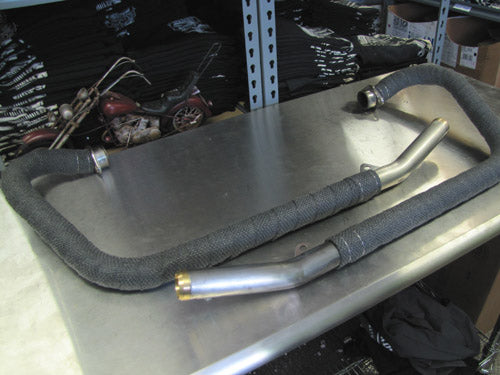
How to wrap your motorcycle exhaust ?
Wrapping exhaust pipes is a pretty easy process.
Before we get into the nuts and bolts of how to do it, let’s just dispel a few rumors and state a few facts about pipe wrap so you can better determine if you actually want to do this to your bike.
- Pipe wrap doesn’t produce crazy amounts of horsepower. Sad but true. It may help some bikes tuned in certain ways in some circumstances, but if you’re shopping for power, shop elsewhere. The original use of exhaust wrap was for cars, the idea being to keep underhood temperatures lower so the engine could have access to air that was less hot.
- It’s hard on pipes. Wrap can cause excessive heat and hold and trap moisture and detritus against your exhaust, which will shorten the life of the exhausts. Most manufacturers consider pipe wrapping to be abusive and will not honor warranties for wrapped exhausts.
- It does look crappy after a while. Unless you dig the tattered look of a wrap job coming apart, plan on periodic re-wrapping to keep your exhaust system looking fresh.
- You have to remove your exhaust to wrap it. Seems obvious, yet not everyone knows it.

If you’re still here reading, you’re probably ready to get wrappin’!
Gather supplies
In addition to pipe wrap (make sure you purchase enough — a four-cylinder needs more wrap than a twin!), you’ll also need some wraps to hold them in place. Some folks use safety wire.

Others use special stainless clamps, and radiator hose clamps are also a good option. Or you can make life easy and purchase a pipe wrap kit, which usually includes both wrap and fasteners.

The other items you’ll wanna have handy are some latex gloves and a small bucket. (The gloves are to keep you from being itchy, as most exhaust wraps are made from fiberglass, which causes a deeply irritating itch for many people when it comes into contact with skin.) You’ll also want to have a set of fresh exhaust gaskets handy, too.

Remove exhaust
Unbolt it and take it down. Now would be a good time to examine it for broken weld, pinholes, and cracked brackets. If you’ve got heavy rust or scale, you might want to remove it with a wire brush or wire cup brush. When you're done, clean everything off thoroughly.

Soak your wrap
Remember the bucket you gathered? Drop your rolls of wrap in there and soak ‘em. Some folks will recommend not doing this with colored wraps, as it can pull color from the wrap. I ignore that for a few reasons. First, after a few months of riding, the wrap’s going to have lost a significant amount of color anyway. Secondly, it’s easier to install and keeps the airborne fiberglass at bay, which is probably better for your health than the alternative. Finally, and probably most importantly, wet wrap stretches a bit, so you can wrap tighter and have a nicer-looking finished product.

Start wrapping
Wire down one end of the wrap at the exhaust outlet, and start wrapping, pulling the wrap tight and overlapping the preceding layer roughly halfway with each wrap.

You don't have to affix the end of the wrap if you can get an overlap working fast enough to get it cinched down. In fact, I always do it this way and secure both the start and end points when I'm all done. Wrap from outlet to inlet so that the openings in the overlaps face the rear of the bike, helping keep road scuzz from working its way between the wrap and pipe, or helping the wrap to tear or separate.
If you have to wrap around a bracket or bung, wrap in an "X" and then overlap it, continuing your pattern. (Be careful, though. The pipe wrap can build up unsightly thickness in just a few layers. ) Remember to make it look nice on the “show” side of the pipe. Nobody will notice a gap or exposed section of pipe that faces the inside of the bike.

Finish it off
Affix the wrap to the manifold end. (If you have removable exhaust flanges, make sure they’re installed before attacking this step.) If you’re using safety wire, bury the twisted section of wire in the wrap so you don’t stick yourself if you get near it.

Reinstall your pipes
Don’t forget the fresh gaskets!

Fire it up
Take it for a spin. It’s gonna off-gas a whole bunch of smoke and bad smells, and that will subside with time. Get that bike good and hot and drive off as much as you can right off the bat. Be aware that the wrap will discolor. Black wrap turns charcoal, and white wrap gets dingy. It’s that easy! Even your first attempt should look pretty great if you take even a modicum of care.
Happy wrapping
LEMMY
